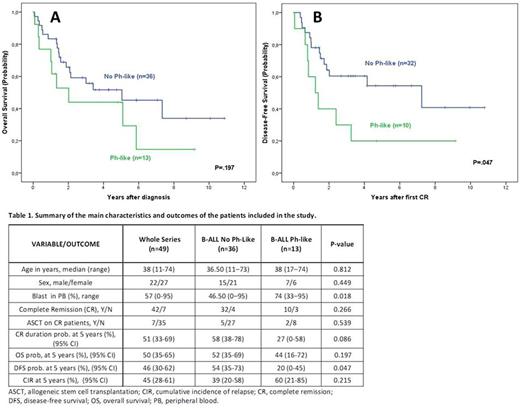Abstract
Background: BCR-ABL1-like (Ph-like) B-precursor acute lymphoblastic leukemia (ALL) shows a gene expression profile closely related to B-precursor ALL with Philadelphia (Ph) chromosome rearrangement. In addition, Ph-like ALL patients are characterized by common genetic alterations and inferior prognosis, as has been shown in pediatric and adult studies. The aim of this study was the genetic and clinical characterization of Ph-like ALL by RNAseq in a series of adolescent and adult ALL patients included in risk-adapted trials from the Spanish PETHEMA group.
Methods:Fourty-nine adolescents and adults with Ph-negative B-ALL (median age 38 years, range 11-74) were included in this study. RNA-Seq custom panel of 42 genes related to the Ph-like signature (AmpliSeq, Thermo Fisher) was carried out in a S5 sequencer (Thermo Fisher). The total reads were employed to build a hierarchical clusterized heatmap with Morpheus software (Broad Institute). Mutations related to the Ph-like genotype were studied after sequencing 31 patients with a custom panel formed by 35 genes. All samples were sequenced in S5 Ion Torrent equipment. CRLF2 overexpression was analyzed by real time PCR.Contingency tables were used to analyze associations between categorical variables (χ2). Median test was used to compare medians of continuous variables between groups. Complete remission (CR) duration, disease-free survival (DFS) and overall survival (OS) curves were estimated using the Kaplan-Meier method and compared between patients using the log-rank test.
Results: Thirteen out of 49 patients were classified as Ph-like (26%) based on heatmap aggrupation. There were no significant differences in baseline characteristics like age, gender, ALL sub-type, and cytogenetics, in comparison with B-ALL other subgroup (n=6, 74%). Additionally, most patients with high CRLF2 expression were classified into the Ph-like ALL subgroup (11/13, 85% vs 7/36, 19% of no Ph-like. Complete remission (CR) was attained in 42 patients (86%). At 5 years, the Ph-like ALL subgroup showed a trend to lower probability of CR duration compared to non Ph-like group (95% CI): 27% (0-58%) vs. 58% (38-78%), p=0.086. No significant differences were observed in OS (95% CI): 44% (16-72%) vs. 52% (35-69%), p=0.197), but Ph-like patients showed significantly shorter DFS probability at 5 years (95% CI): 20% (0-45%) vs. 54% (35-73%), p=0.047, (Figures 1a and 1b). A summary of the main characteristics and outcomes of the patients is presented in the Table 1. Mutations of IKZF1, KRAS, JAK2, CRLF2, NRAS, JAK1, TYK2 and PAX5 genes related to Ph-like genotype represented 7/11 Ph-like patients (64%) vs 3/20 no Ph-like (15%). Data of a validation cohort of patients will be presented.
Conclusion: Targeted RNA-Seq could identify a Ph-like B-ALL subgroup within adolescents and adults with Ph-negative B-ALL homogeneously treated with risk-adapted protocols. This Ph-like B-ALL subgroup showed lower DFS probability than the remaining Ph-negative B-ALL patients.
Ribera: Gilead: Honoraria; Janssen: Honoraria; Celgene: Honoraria; Incyte: Research Funding, Speakers Bureau; Pfizer: Research Funding, Speakers Bureau; Amgen Inc.: Research Funding, Speakers Bureau; Roche: Honoraria; ARIAD: Research Funding, Speakers Bureau.
Author notes
Asterisk with author names denotes non-ASH members.


This feature is available to Subscribers Only
Sign In or Create an Account Close Modal